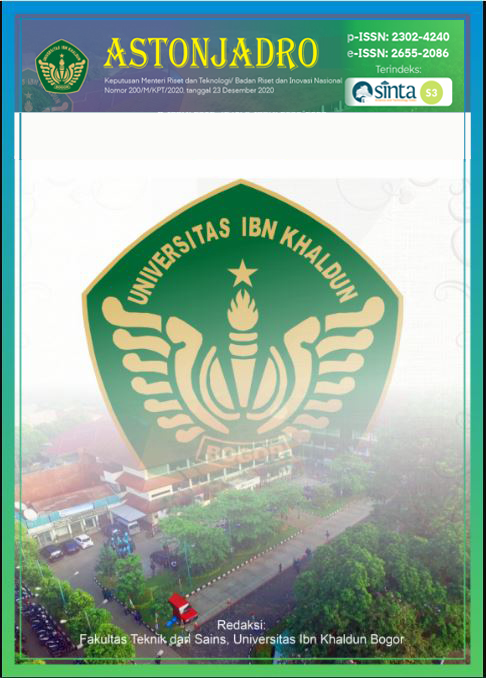Analysis of Mode Integration Facilities at Madiun Station
DOI:
https://doi.org/10.32832/astonjadro.v13i2.14948Keywords:
mode integration facility; modal interaction matrix; trip segment analysis.Abstract
One of the problems that occur at Madiun Station is the need for modal integration. Modal integration can be interpreted as a complete integration of the types or forms (transport) used to move people and goods from one place (origin) to another (destination). Some problems related to modal integration at Madiun Station are not optimal pedestrian facilities, no clear drop zone point for public transport passengers, and more information instructions regarding connecting transportation. In this study, data collection methods were used by observing the existing conditions of the modal integration facilities in the Sriwijaya Earth Station area. Furthermore, a survey was conducted on LRT passengers at Madiun Station regarding the characteristics of LRT service users and the public's willingness to access modal integration facilities. This study uses the Modal Interaction Matrix and Trip Segment Analysis Method. The results of this study using the Modal Interaction Matrix analysis show that the modal integration facility in the Madiun Station area has an interaction level of -160 or can be categorized as a bad interaction. By providing a proposal for the location of the modal integration facility, it can be seen that the interaction value of the modal integration facility at the Sriwijaya Earth Station has increased to -80 or has a Good category. Furthermore, through calculations using the Trip Segment Analysis method, the greatest time value is for public transport users when they want to access the station or when they want to leave the station. The value of the time needed to access the station for public transport users is 15.3 minutes. And it takes 14.4 minutes for train service users who get off at Madiun Station and want to continue their journey using public transportation.
References
Alan J. Horowitz, and ick A. Thompson. 1994. “Evaluation of Intermodal Passenger Transfer Facilities.”
Aryantono, and Nanang. 2009. “Penyusunan Indikator Pelayanan Transportasi Antarmoda Di DKI Jakarta, Medan, Surabaya Dan Yogyakarta Dalam Rangka Perwujudan Keterpaduan Transportasi Perkotaan Yang Optimal Dan Efektif”, Warta Penelitian Perhubungan.”
Badan Pusat Statistik. 2020. Badan Pusat Statistik Kabupaten Kendal 2020. Dempsey, P S. 2000. The Law Of Intermodal Transportation: What It Was, What It Is, What It Should Be.
Eka Ari Fianti. 2019. “Kajian Integrasi Antar Moda Pada Stasiun Solo Balapan Kota Surakarta.”
Institute for Trasnportation & Development Policy. n.d. Pedoman Integerasi Moda. John A Martilla; John C James. 1997. “Importance- Performance Analysis.”
Peraturan Menteri Pekerjaan Umum Nomor 02 Tahun 2018 Pekerjaan Umum Tentang Pedoman Perencanaan Teknis Fasilitas Pejalan Kaki.
Keputusan Menteri Perhubungan Nomor 49 Tahun 2005 Tentang Sistem Transportasi Nasional (SISTRANAS),.
Natalia Tanan. 2011. “Pusat Penelitian Dan Pengembangan Jalan Dan Jembatan.”
Puslitbang Multimoda. 2013. “Studi Penyusunan Pedoman Penilaian Tingkat Keterpaduan Transportasi Antarmoda.”
S. Krygsman. 2004. Activity and Travel Choice(s) in Multimodal Public Transport Systems. Spek, S, C, van der. 2001. “The Development of Architectural Design Theory Specifically Directed at Intermodal Transfer Building for Multimodal Passenger Transportation.”
Tamin Ofyar, Z. 2008. Perencanaan, Permodelan, Dan Rekayasa Transportasi.
Win Akustia. 2016. “Evaluasi Keterpaduan Antrarmoda Transportasi Di Kota Gorontalo.”
Errampalli, M., Patil, K., & Prasad, C. (2020). Evaluation of Integration Between Public Transportation Modes by Developing Sustainability Index for Indian Cities. Case Studies on Transport Policy, 8(1), 180-187. Doi: https://doi.org/10.1016/j.cstp.2018.09.005
Pradana, M. F., Budiman, A., & Arif, I. (2018). Evaluasi Pelayanan Stasiun Tangerang Kota Tangerang. Jurnal Kajian Teknik Sipil, 3(2), 94-104.
Rizky, A. (2013). Konsep Integrasi Moda Transportasi Publik di Kota Surabaya Berdasarkan Preferensi Masyarakat. (Thesis), Institut Tekonologi Sepuluh Nopember, Surabaya
Hutabarat, S.P., "Analisis Perilaku Perjalanan Komuter yang Memilih Menggunakan Sepeda Motor daripada KRL sebagai Moda Utama untuk Aktivitas Bekerja (Studi Kasus: Jabodetabek).," Tesis. Institut Teknologi Bandung, Bandung, 2022
T. F. Schubert, E. Henning and S. B. Lopes, "Analysis of the Possibility of Transport Mode Switch: A Case Study for Joinville Students," Sustainability, Vols. 12, 532, pp. 1-22, 2020
Putri, E. M., & Herwangi, Y. (2023). Analysis of Land Use Developments Along the LRT Line (Case Study: Polresta, Jakabaring and DJKA Station’s). ASTONJADRO, 12(3), 761–768. https://doi.org/10.32832/astonjadro.v12i3.9442
Santoso, G. P., & Dwiatmoko, H. (2023). Analysis of transportation mode choice for Electric Rail Train (KRL) and bus for Yogyakarta-Surakarta travel routes. ASTONJADRO, 12(1), 283–292. https://doi.org/10.32832/astonjadro.v12i1.8628
Sihombing, S. B., Lubis, S., & Wijaya, M. A. (2021). REDESIGN OF RANTAU PRAPAT TRAIN STATION. ASTONJADRO, 10(2), 393–408. https://doi.org/10.32832/astonjadro.v10i2.5471
Syaiful, S., & Rulhendri, R. (2014). Kajian Tentang Angkutan Kereta Api Jabodetabek. ASTONJADRO, 3(2), 63–68. https://doi.org/10.32832/astonjadro.v3i2.816
Syaiful, S., & Fadly, A. (2020). ANALYSIS OF THE EFFECTIVENESS OF BUS SERVICES OUTSIDE OF CAMPUS IPB DRAMAGA BOGOR. ASTONJADRO, 9(2), 173–186. https://doi.org/10.32832/astonjadro.v9i2.3597
Savitri, A., Murtejo, T., & Rulhendri, R. (2020). KAJIAN TINGKAT KEPUASAN PELANGGAN TERHADAP KINERJA TRANSPAKUAN BOGOR (Studi kasus: Pelayanan di Halte dan Pelayanan di dalam Bus Transpakuan Bogor). ASTONJADRO, 6(2), 97–103. https://doi.org/10.32832/astonjadro.v6i2.2266
Syaiful, S., Yulianto, M., Murtejo, T., & Rulhendri, R. (2023). Analysis of the Function and Convenience of Pedestrian Public Transport Support the City of Bogor . ASTONJADRO, 12(3), 646–657. https://doi.org/10.32832/astonjadro.v12i3.4341
Fahrizal, I., & Dwiatmoko, H. (2023). Analysis of the selection of land transportation modes in Serang City. ASTONJADRO, 12(2), 571–582. https://doi.org/10.32832/astonjadro.v12i2.9781
Sekarsari, M., & Dwiatmoko, H. (2022). Impact of traffic congestion on road users in Tangerang City. ASTONJADRO, 11(3), 608–615. https://doi.org/10.32832/astonjadro.v11i3.7428
Chakam, M. F., & Rakhmatulloh, A. (2024). Study on Service Quality and Priorities of Pedestrian Path Development in Malioboro Area to Support Sustainable Urban Mobility. ASTONJADRO, 13(1), 138–145. https://doi.org/10.32832/astonjadro.v13i1.14534
Arifin, W. (2024). Assessment of Public Transport Footway Facilities Bogor District. ASTONJADRO, 12(3), 658–674. https://doi.org/10.32832/astonjadro.v12i3.4342 (Original work published October 6, 2023)
Downloads
Published
How to Cite
Issue
Section
License
Copyright (c) 2024 ASTONJADRO

This work is licensed under a Creative Commons Attribution-ShareAlike 4.0 International License.
Paper submitted to ASTONJADRO is the sole property of the Astonjadro Journal. Unless the author withdraws the paper because he does not want to be published in this journal. The publication rights are in the journal Astonjadro.ASTONJADRO
LICENSE
This work is licensed under a Creative Commons Attribution-ShareAlike 4.0 International License.
Based on a work at http://ejournal.uika-bogor.ac.id/index.php/ASTONJADRO













